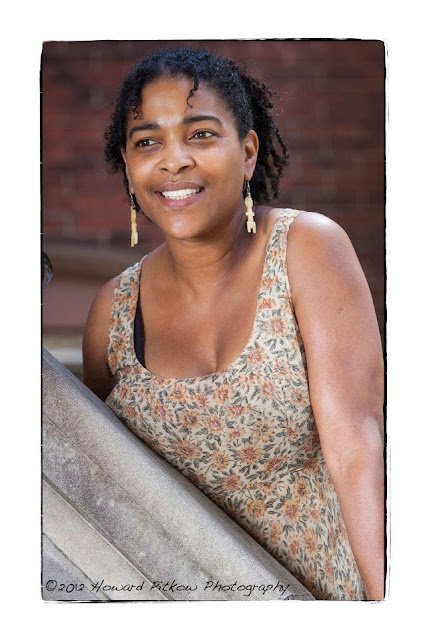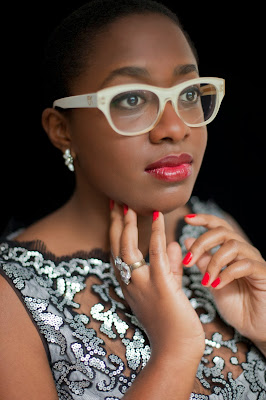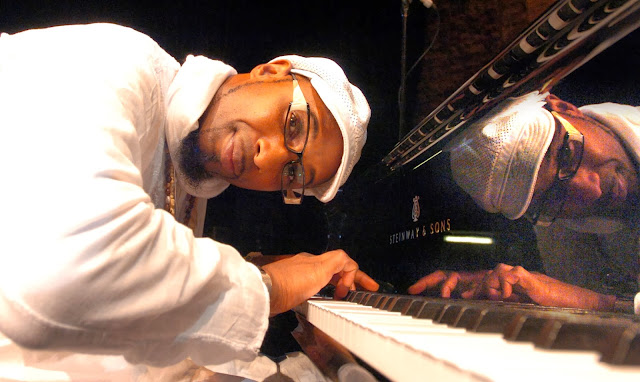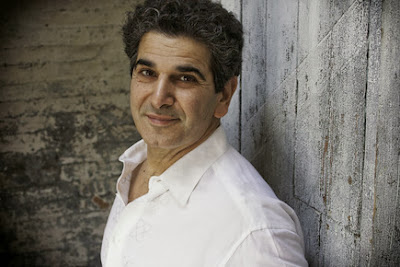
Jazz guitarist Roni Ben-Hur has earned a sterling reputation as a musician and educator, renowned for his golden tone, improvisational brilliance, compositional lyricism and ability to charm peers, students and listeners alike. Eminent jazz critic Gary Giddins wrote in the Village Voice: "A limber and inventive guitarist, Ben-Hur keeps the modernist flame alive and pure, with a low flame burning in every note... [He's] a guitarist who knows the changes and his own mind." Ben-Hur - born in Israel in 1962 but a longtime American citizen, now based in New Jersey - has released nine albums as leader or co-leader, with Time Out New York calling him "a formidable and consummately lyrical guitarist." The Star-Ledger of New Jersey summed him up this way: "A deep musician, a storyteller, Ben-Hur works with a warm, glowing sound and has an alluring way of combining engaging notes with supple rhythm." Along with releasing acclaimed educational products - including the instructional DVD Chordability and method book Talk Jazz: Guitar - Ben-Hur has directed international jazz camps for nearly 15 years. Jazz guitar star Russell Malone got it right when he said: "Everything Roni does is beautiful. He has the magic touch."
Ben-Hur's latest album is Our Thing (Motéma Music, 2012), a co-led trio project with Panamanian-born bassist Santi Debriano that also features Brazilian drummer Duduka Da Fonseca. Marked by soulful grooves, telepathic interplay and a rich, organic ensemble sound, Our Thing ranges from deeply swinging interpretations of Thelonious Monk's "Green Chimneys" and Irving Berlin's "Let's Face the Music and Dance" to a pair of poetic tunes by Antonio Carlos Jobim and several beautiful originals that channel the players' Middle Eastern, Latin and Brazilian heritages through a post-bop prism. One of Ben-Hur's compositions is a fresh rendition of a longtime favorite in his songbook: "Anna's Dance," written for one of his two daughters. DownBeat called Our Thing "mesmerizing," while New York City Jazz Record captured it colorfully: "Ben-Hur, Debriano and Da Fonseca sway with the grace of palm trees, exuding a laidback introspection." The Buffalo News encapsulated the album by describing it as "delectable jazz internationalism of near-Olympic variety. Ben-Hur and Debriano are players of first-rate fluency and taste."
Ben-Hur's family relocated from Tunisia to Dimona, Israel, where he was born into large family - teaching him good ensemble values early on. The guitarist began playing in wedding bands and in Tel Aviv clubs as a teenager enraptured by the recordings of Wes Montgomery, Grant Green, Jim Hall and Kenny Burrell. The young musician also came to love the classical Spanish repertoire via Segovia, hearing a Moorish sound that resonated with his family's North African roots. Later, after moving to New York in 1985, he would fall for Brazilian music, particularly through the work of guitarist-composer Baden Powell. When Ben-Hur came onto the New York jazz scene, he was fortunate to be taken under the wing of veteran jazz pianist Barry Harris, a Monk disciple and Grammy Award-winner who led the influential Jazz Cultural Theater during the mid-'80s in Manhattan. The up-and-coming guitarist played in Harris's band, absorbing musical wisdom and life lessons.
Teaching has become increasingly important to Ben-Hur over the years, as he has developed an international reach as an educator. As founder and director of the jazz program at the Lucy Moses School at the Kaufman Center in Manhattan since 1994, Ben-Hur has educated a multitude of jazz enthusiasts in ensemble playing, improvisation and jazz guitar. Along with his jazz camp with Santi Debriano in the South of France, Ben-Hur led camps for years in Patterson, N.Y. More recently, through his company Adventures in Jazz - which he operates with his wife, singer Amy London - Ben-Hur conducts jazz camps in Cabo Rojo, Puerto Rico, in Istanbul, Turkey, and in Schroon Lake, N.Y., teaching workshops in straight-ahead jazz, Latin jazz and Brazilian jazz with Debriano and other teachers. With Brazilian bassist Nilson Matta, Ben-Hur also co-leads Samba Meets Jazz camps in Paraty, Brazil, and in Bar Harbor, Maine.
With his partner in the Samba Meets Jazz camps, bassist Nilson Matta, Ben-Hur released the album Mojave (Motéma, 2011), which also featured drummer Victor Lewis and percussionist Café. The album was the second in Motéma's Jazz Therapy series. The series was co-founded by Ben-Hur and the label to raise money and awareness for the Dizzy Gillespie Memorial Fund of New Jersey's Englewood Hospital and Medical Center Foundation, which provides care for uninsured jazz musicians. The first album in the series wasSmile, Ben-Hur's 2008 duo set with veteran guitarist Gene Bertoncini.
Ben-Hur and Matta are each masters of a musical tradition, the guitarist with bebop and the bassist with samba. Mojave sees them meld the two worlds, in league with New York jazz drummer Victor Lewis and Brazilian percussionist Café. They range from pieces by such Brazilian icons as Jobim, Baden Powell and choro pioneer Pixinguinha to Burt Bacharach's "The Look of Love" and deftly rhythmic originals by all four players. One of Ben-Hur's contributions is the moody beauty "Eretz" (Hebrew for "land"), another of his signature tunes interpreted afresh. The Rochester City Newspaper offered a glowing review of the album: "Mojave is magical from start to finish... The combination of Matta's samba and Ben-Hur's swing is a marriage made in heaven.
Acclaim for Smile, Ben-Hur's dual-guitar album with Gene Bertoncini, was equally wide-spread. The New York Times lauded the "sophisticated and lyrical" musicianship, and DownBeat simply called the album "stunning," as the players stretch from the Charlie Chaplin title track and the Arlen-Mercer standard "Out of This World" to an enterprising take on Roberta Flack's hit "Killing Me Softly" and two of Ben-Hur's personal standards - his "Anna's Dance," written for one daughter, and "Sofia's Butterfly," penned for the other. Jazz sage Nat Hentoff praised the "lyrically meditative dialogue" between the two guitarists in the Wall Street Journal, while the Washington Post was enamored by "the dazzling dexterity and tasteful elegance of these duets."
Two other key albums in Ben-Hur's discography are Fortuna (Motéma, 2009) and Keepin' It Open (Motéma, 2007), both quintet sets with piano vet Ronnie Matthews and ultra-swinging drummer Lewis Nash, plus percussionist Steve Kroon. Keepin' It Open, which also includes bassist Santi Debriano and trumpeter Jeremy Pelt in the group, has a wide purview, from Monk's rollicking "Think of One" to a dark-hued old Sephardic melody, "Eshkolit." Tapping into his family's Sephardic Jewish roots and his love of the Spanish classical guitar repertoire, Ben-Hur recasts Granados' "Andaluza" as an ensemble piece. And the guitarist's originals include the finger-snapping "My Man, Harris," a tribute to his mentor Barry Harris. JazzTimes called the album "a delight from start to finish," while critic Scott Yanow singled out the guitarist on All Music, saying that Ben-Hur "can swing as hard as anyone."
Fortuna, which has Rufus Reid on double-bass, sees Ben-Hur recast Albéniz's "Granada" with an ear for the early Israeli popular music influenced by the Moorish sound. Along with two Jobim numbers, the disc includes the Irving Berlin ballad "I Got Lost in his Arms" and Ben-Hur's funky original "Guess Who." Jazz scholar Dan Morgenstern listed Fortuna as one of his top 10 discs of 2009. JazzTimes described the album this way: "A keen story teller, Ben-Hur's dexterous, melodic and emotive playing is supported by a tight-knit cast of stellar musicians... his skill and warm tone underscoring the band's chemistry." All About Jazz said, "Fortuna is a sparkling ode to the brightness of life."
Ben-Hur's album Signature (Reservoir, 2005) put the guitarist in the company of pianist John Hicks, bassist Rufus Reid and drummer Leroy Williams, again plus percussionist Steve Kroon. The tracks include the first appearance of Ben-Hur's gem "Eretz," plus two pieces by Villa-Lobos and tunes by Jobim and Cole Porter. DownBeat said: "Signature is a collection of consummately played music that matches the six-stringer's consistently creative melody reading, soloing and comping with the supportive work of superb sidemen. Ben-Hur's original compositions are similarly impressive, from opening burner 'Mama Bee,' which dazzles with a brilliantly constructed guitar solo, to 'Eretz,' a gorgeous ballad intended as a tribute to the guitarist's native Israel that feels like an instant standard."
For Anna's Dance (Reservoir, 2001), Ben-Hur convened a combo of elders: Barry Harris on piano, Charles Davis on saxophone, Walter Booker on double-bass and Leroy Williams on drums. The highlights include the debut of Ben-Hur's title composition, as well as the Billy Strayhorn ballad "A Flower Is a Lovesome Thing." In the Village Voice, Gary Giddins said: "As eloquent as a cool breeze, this understated exercise in bebop equilibrium goes down so easy that you might underestimate the magic. Ben-Hur and Charles Davis, who trades in his Sun Ra baritone for suave tenor, speak Harris's lingo like natives." Ben-Hur's kick-started his discography with two bebop showcases.Sofia's Butterfly (TCB, 1998) saw the guitarist - with drummer Leroy Williams and bassist Lisle Atkinson in tow - offering much promise; there's the ultra-fluid virtuosity of his take on Monk's "Four in One," not to mention the first appearances of his original title tune and "Fortuna." Ben-Hur made his initial splash on record with Backyard (TCB, 1996), which presented him with the Barry Harris Trio.
In addition to leading his own bands, Ben-Hur has shared the stage and the studio not only with the heroes and great peers mentioned above but with the likes of Cecil Payne, Etta Jones, Marcus Belgrave, Charles McPherson, Jimmy Heath, Clark Terry, Slide Hampton, Earl May, Teri Thornton and Bill Doggett. Ben-Hur regularly performs in the top jazz venues and in major festivals across the country and around the world. As an educator, he has established jazz programs in New York City high schools, along with presenting workshops for students of all ages in the U.S. and Europe. His instructional releases include the DVD Chordability (Motéma, 2011), which offers 20 lessons on chord voicings and jazz harmony for intermediate and advanced guitarists. He also translated "the Barry Harris method" to guitar with the publication Talk Jazz: Guitar (Mel Bay, 2003), which has appeared in English and Japanese editions.
Ben-Hur’s latest album is Our Thing (Motéma Music, 2012), a co-led trio project
with Panamanian-born bassist Santi Debriano that also features Brazilian
drummer Duduka Da Fonseca. Marked by soulful grooves, telepathic interplay
and a rich, organic ensemble sound, Our Thing ranges from deeply swinging
interpretations of Thelonious Monk’s “Green Chimneys” and Irving Berlin’s “Let’s
Face the Music and Dance” to a pair of poetic tunes by Antonio Carlos Jobim and
several beautiful originals that channel the players’ Middle Eastern, Latin and
Brazilian heritages through a post-bop prism. One of Ben-Hur’s compositions is a
fresh rendition of a longtime favorite in his songbook: “Anna’s Dance,” written for
one of his two daughters. DownBeat called Our Thing “mesmerizing,” while New
York City Jazz Record captured it colorfully: “Ben-Hur, Debriano and Da Fonseca
sway with the grace of palm trees, exuding a laidback introspection.” The Buffalo
News encapsulated the album by describing it as “delectable jazz
internationalism of near-Olympic variety. Ben-Hur and Debriano are players of
first-rate fluency and taste.”










